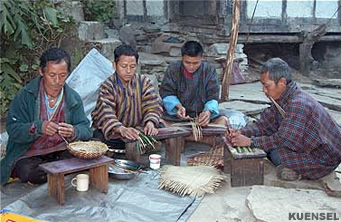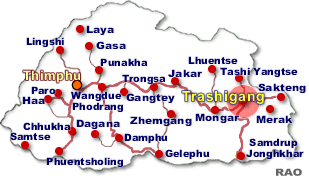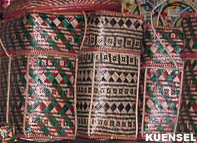 |
Bhutan Agricuture |
 |
Bhutan Information |
|
|
 |
| Trashigang:
Cane production - Pasaphu: sustaining a tradition? |
 |
 |
| Working with cane is a daily affair in almost every household |
| It
all began in 1988 Farmer Sangay Wangdi of Pasaphu village in Thrimshing,
Trashigang, took along a few cane products from the village on his visit
to a relative in Thimphu who owned a handicraft shop.
The
products were displayed in the shop and it sold out quickly, much to Sangay
Wangdi's surprise.
|
|
When he returned to his village, a six-hour climb from
Phekpari, he narrated the experience to friends and neighbours. Encouraged,
they started making more cane products.
Several
months later Sangay Wangdi headed for Thimphu again, this time accompanied
by a couple of friends and a lot more cane products.
"Until
then, cane products were made only for domestic use," said Sangay Wangdi,
60, who supplies cane products to several handicraft shops in Thimphu and
a few other places as well.
Working
with the cane species, locally called ringshu, is a daily affair in almost
every household in Pasaphu and in recent years both men and women have
started producing cane products for sale. Some villagers have given up
fieldwork to be fully engaged in producing cane goods as a means of livelihood.
According
to Sangay Wangdi, who started making cane products at the age of 16, cane
streaks were dried and soaked in dyes imported from India.
 |
| Several dyes
were also blended to obtain other colours. The skills then came into play
to weave the strips of coloured cane into various shapes with intricate
patterns.
Earlier
the most popular product was the bangchung, used as plates or for storing
edibles, hats, worn as protection from sun and rain while travelling and
working in the fields and mats, which are also used to fence and partition. |
|
top
|
Pasaphu:
potato cave
|
 |
Present
Pasaphu village once fell along the main trade route for the people of
Kangpara, who journeyed to Martshala and Gomdar in Samdrup Jongkhar to
trade for salt and cloth.
According
to village elders, travellers usually halted for the night in a cave in
Pasaphu. It so happened that some travellers had dropped some potatoes,
called pasong in local dialect, in the cave. Potato was rare in the area
then.
Travellers
that followed few months later saw the tuber growing and cooked it for
a meal. Since then the travellers had called the place Pasangphu (potato
cave). Over the years it changed to Pasaphu.
"The
tradition of cane weaving has existed for long time here," he said. "At
one time our parents bartered the goods with people from neighbouring villages
for agriculture products," he said.
Today
competition from other regions in the country and availability of similar
foreign goods in the market had forced many in the village to take up innovative
productions, said Sangay Wangdi.
There
were more than 40 households in the village, which produced more than 50
varieties of products like pencil stands, bags, slippers, cups, and holders
besides the regular traditional products. Some cane craftsmen in the village
had had the opportunity to participate in workshops and exhibitions.
 |
| Cane
quivers, baskets and bangchungs |
| Sangay
Wangdi said that when he and some of his friends went to Guwahati, India,
on a government-sponsored trip few years back, they were introduced to
many new ideas. The designs and patterns were copied on paper and shared
with craftsmen back home.
The
villagers prefer to sell all their products to Sangay Wangdi who supplies
them to various handicraft outlets around the country.
|
|
He has his own handicraft
shop in the village to cater to visiting government officials."The
transportation charges are too high," said 36-year-old Karma Phuntsho,
a cane craftsman. "The small quantity we produce would not meet the expenses,
so it is better to sell it to Sangay Wangdi." The prices of the products
varied from Nu. 40 to Nu.1,000 in the village. In Thimphu it sold for double
the price.
But
while it has proven to be an important source of income for the villagers,
its commercialisation has led to extinction of the cane species in the
locality. Every year, a group of fifteen people from the village brings
the cane species from Marthang, and Rimung in Samdrup Jongkhar and Narphung
in Pemagatshel.
"With
more people in business now, there has been over harvesting and the species
has disappeared," said Karma Phuntsho. "We have to arrange food and lodging
and hire trucks and people to carry it back home."
He
said that it was a hassle to get permits. "The formalities are very complicated
and we have to go all the way to Trashigang," he said.
According
to the gewog Renewable Natural Resources extension forest officer, Sonam
Wangchuk, excessive cultivation had lead to the exhaustion of the cane
species in the locality.
Last
year, a group of 32 farmers had planted about 3,000 shoots brought from
Samdrup Jongkhar in about 15 acres of land but continuous sunshine had
destroyed the plantation.
Sonam
Wangchuk said that the Japan International Cooperation Agency had given
a fund of Nu. 300,000 to create a nursery. "We are now encouraging community
forestry and using private spaces for plantation," he said.
Meanwhile,
customers say that the prices of the products were unreasonably high. "Unless
they are aiming the tourists they should have a different rate for the
locals," said Pem, a corporate employee. Another said that most of the
products had bad finishing.
But
the villagers claim that it required immense hard work, skill and it was
time consuming. "Even weaving a small bangchung takes three days," said
Wangmo, a mother of three, adding that it involved a lot of work before
it was actually made.
| This
article was contributed by Kesang Dema KUENSEL, Bhutan's National Newspaper,
2006 |
 |
| Information on Bhutan |
 |
|






